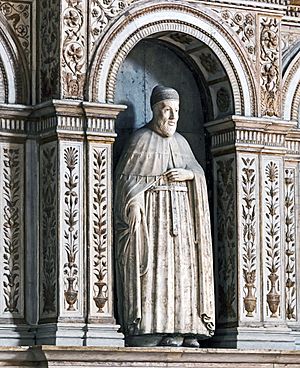Antonio Rizzo (architect) facts for kids
Quick facts for kids
Antonio Rizzo
|
|
|---|---|

Bust of Antonio Rizzo at the Biblioteca civica di Verona
|
|
| Born | c.1430 Osteno
|
| Died | c.1499 Cesena
|
| Known for | Sculpture, architecture |
|
Notable work
|
Scala dei Giganti (Doge's Palace, Venice) |
| Movement | Renaissance |
Antonio Rizzo (born in Osteno, around 1430 – died in Cesena, around 1499) was a talented Italian architect and sculptor. He was one of the most important artists working in Venice during the second half of the 1400s. One of his most famous designs is the Scala dei Giganti (which means Staircase of the Giants). This grand staircase leads to the main rooms of the Doge's Palace in Venice.
Contents
Who Was Antonio Rizzo?
Early Life and Training
Antonio Rizzo was the son of Rizzo di ser Giovanni. He learned his skills as an artist at the Certosa di Pavia, a famous monastery. From 1457, he started working in Venice. He joined the workshop of another artist named Antonio Bregno.
Around 1469, Antonio Rizzo married Maria. She was the daughter of an administrator for a Benedictine nunnery. They lived in a house that belonged to the nunnery of Santa Zaccaria. They also had a son named Simplicio. Simplicio later became a goldsmith in Rome.
Rizzo as a Military Engineer
Antonio Rizzo was not just an artist. He also served as a military engineer. In 1474 and 1478, he was sent to Scutari. This town was being attacked by the Ottoman Turks during a war. His job was to make the town's defenses stronger.
Rizzo was praised for always doing his duty for his country. He even got injured while working. Even though the town's main fort was lost, Rizzo was rewarded. He received a monthly payment for twenty years for himself and his family.
Chief Architect of the Doge's Palace
In 1484, Rizzo was given a very important job. He was made the proto, or chief architect, for the Doge's Palace. This meant he was in charge of fixing and rebuilding parts of the palace.
His successful career ended suddenly around 1498. He faced serious accusations about handling money. He then sold his house and left Venice. He traveled to Ancona, then to Foligno, and finally to Cesena. It is believed he passed away there shortly after.
Antonio Rizzo's Artistic Journey
Early Influences and Works
For many years, people thought Rizzo worked on the large cloister at the Certosa di Pavia in the 1460s. They believed he made columns and other parts there. However, later research showed that the person paid for that work was likely his father.
Rizzo's most important supporter in Venice was the Doge Cristoforo Moro. A Doge was the leader of Venice. Moro asked Rizzo to create altars for the San Marco Basilica. After this, Rizzo became the main sculptor and architect for the Venetian government. This shows he was already very well-known when he arrived in Venice.
Around 1464, Rizzo created sculptures for the tomb of Doge Francesco Foscari. This monument is in the Church of Santa Maria dei Frari. His work included figures of the Annunciation, Allegories, and Virtues. These pieces showed some influence from the Gothic style of Antonio Bregno.
Developing His Style
Around 1467, Rizzo decorated the entrance of the Church of Sant'Elena. He created a work called Vittore Cappello genuflecting before Saint Helena. This sculpture showed a strong sense of realism. Cappello's face looked tense and pleading.
Rizzo's style began to show signs of the new Renaissance movement. This is clear in his statues, like Mars. He made these for the Arco Foscari at the Doge's Palace in the mid-1460s.
In 1476, Rizzo created a spiral staircase with a decorated pulpit for the Scuola Grande di San Marco. Sadly, a fire in 1485 destroyed these works.
Masterpieces: Adam and Eve
Rizzo's style continued to grow. He was influenced by the artist Antonello da Messina. His sculptures became more geometric and had clearer shapes. His statues of Adam and Eve in the Arco Foscari are excellent examples. Also, his Monument to the Doge Tron is outstanding.
Rizzo sculpted Adam and Eve based on real human models. He worked in a very natural way. His figures were not like the perfect, classical statues. For example, his Adam had strong muscles, and Eve had wide hips. These sculptures might have even influenced the famous artist Albrecht Dürer. Dürer visited Venice between 1490 and 1495.
Later Works at the Doge's Palace
Rizzo's final style can be seen in the sculptures on the inner side of the Doge's Palace. After a fire damaged the palace in 1483, he was chosen to redesign a new east wing. He also planned a new apartment for the Doge. His most famous work from this period is the Scala dei Giganti.
These projects kept him busy between 1484 and 1498. The Venetian Senate ordered the reconstruction and appointed Rizzo as the architect. Even though he was known for his sculptures, he had not done much architectural work before. His bravery in Scutari might have helped him get this important job.
Rizzo's east wing was the first part of the Doge's Palace built entirely in the Renaissance style. His Scala dei Giganti is visually stunning. It leads up to a platform with sculptures of Victories below. These sculptures are considered some of his best work. They are special because they look like paintings, using a technique called sfumato. This technique creates soft, blended colors and shadows.
Some people also believe that Rizzo created the bronze statues of the Moors on the St Mark's Clocktower in the Piazza San Marco. These statues were cast in 1497.
See also
 In Spanish: Antonio Rizzo para niños
In Spanish: Antonio Rizzo para niños



